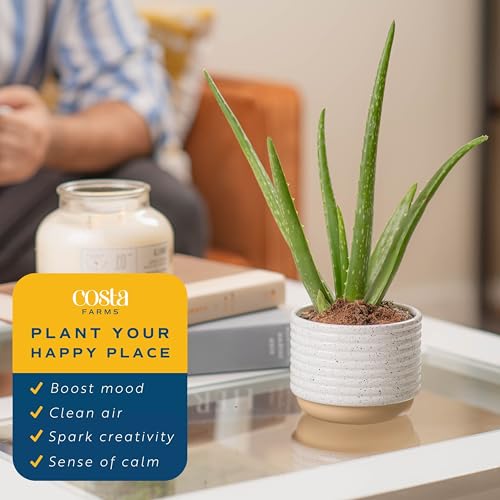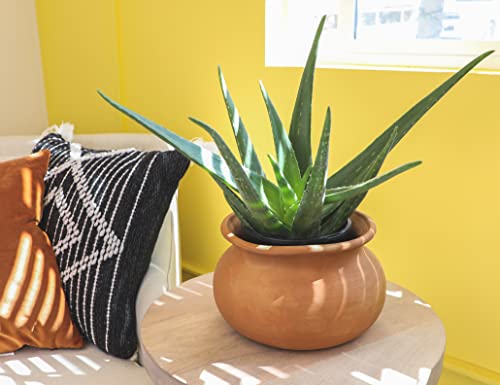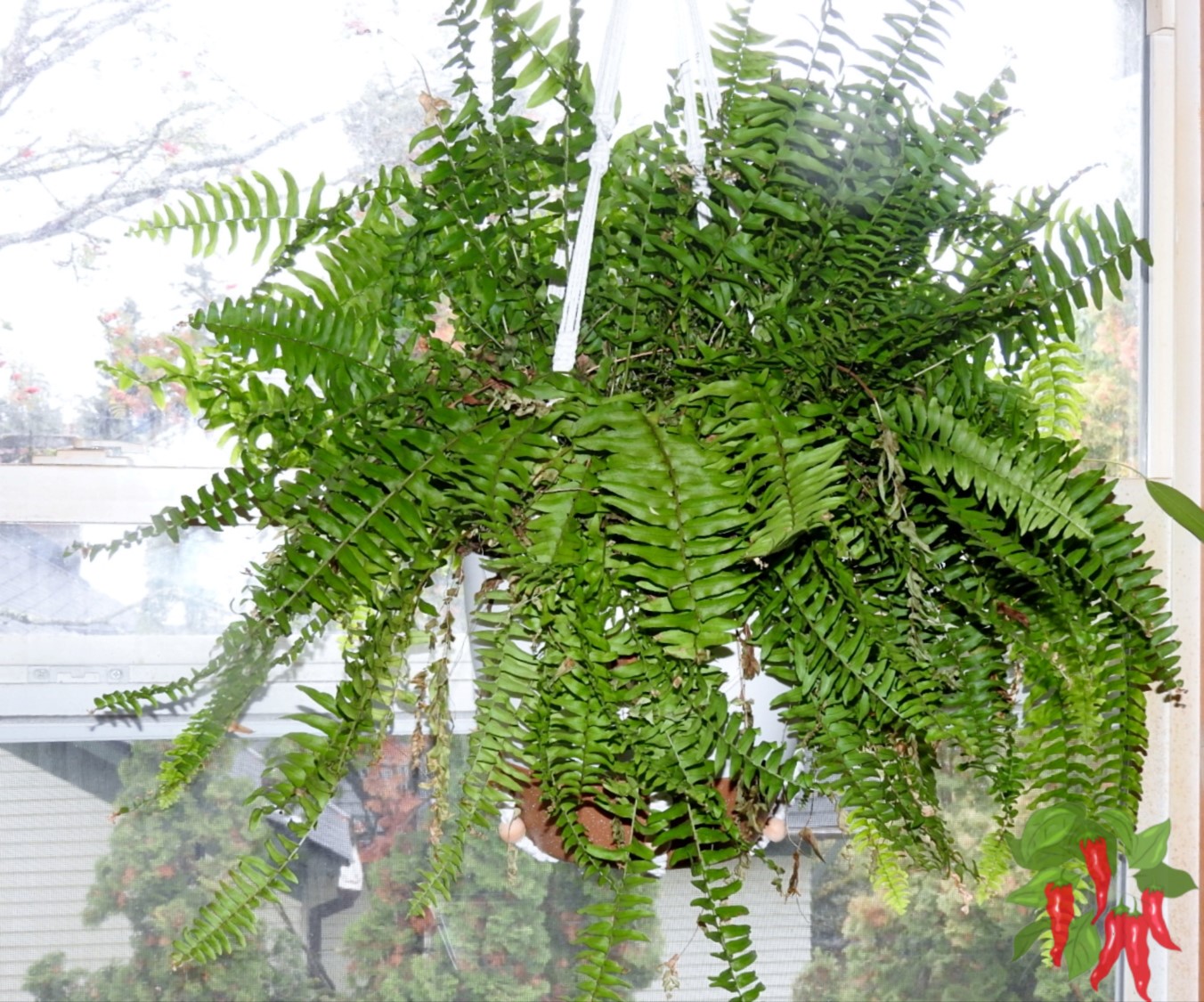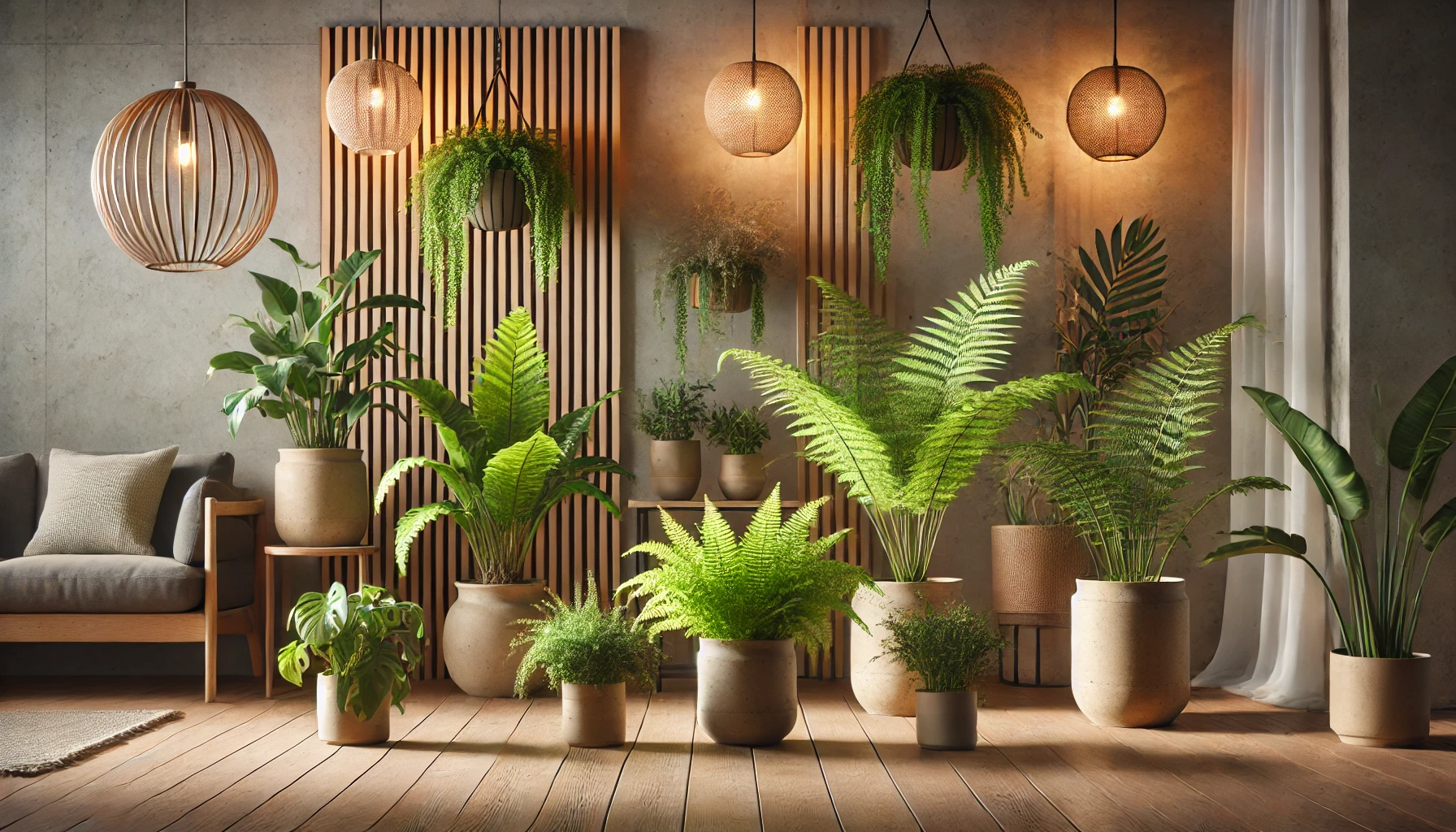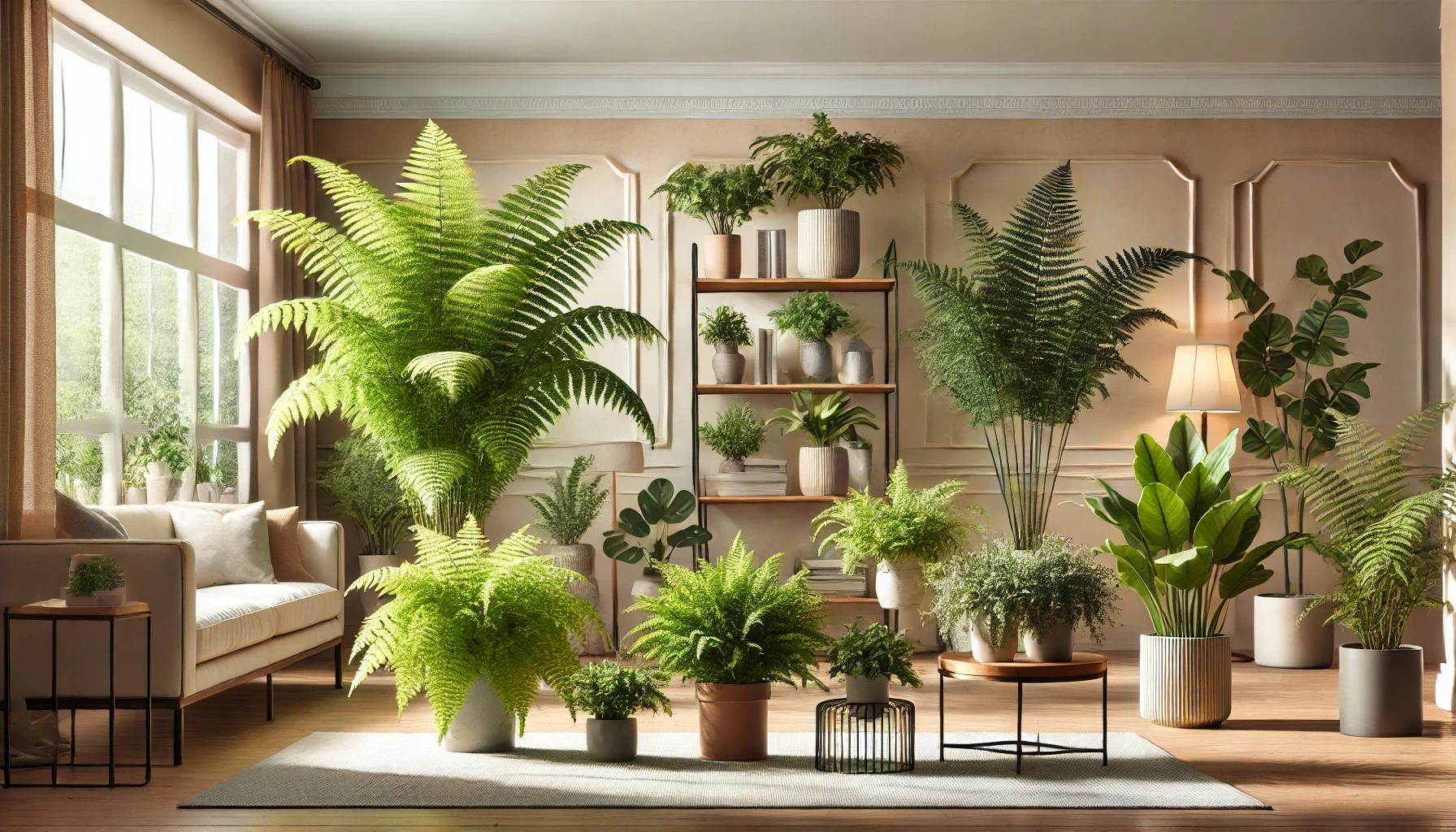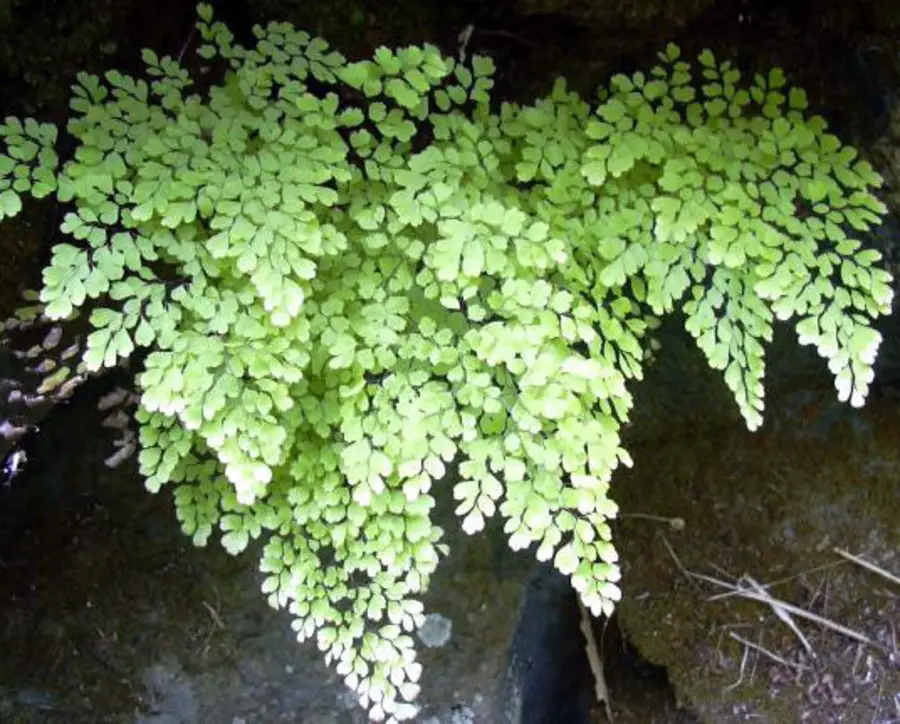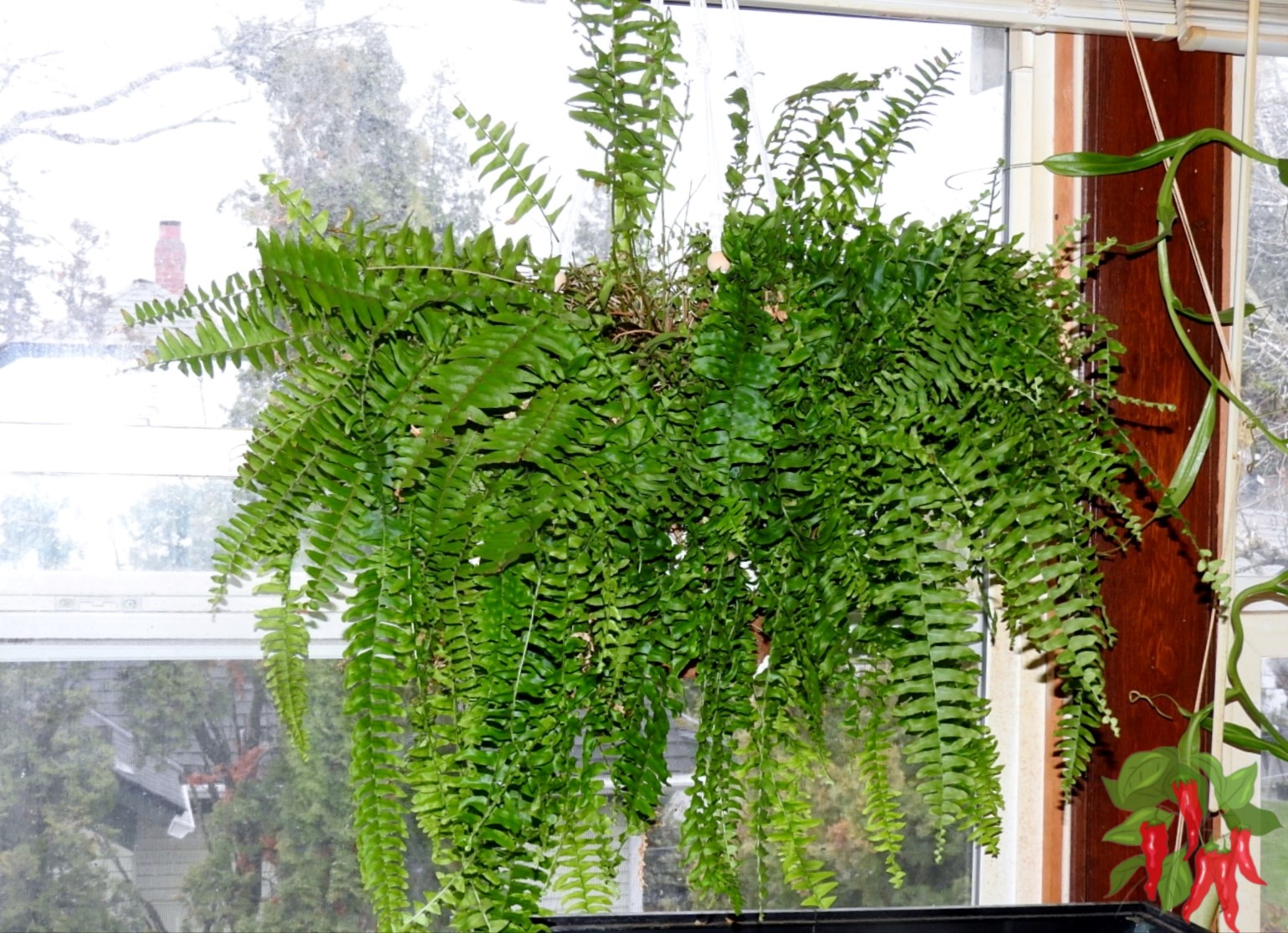This post contains affiliate links. If you buy something from one of our links we may earn a commission. Thanks
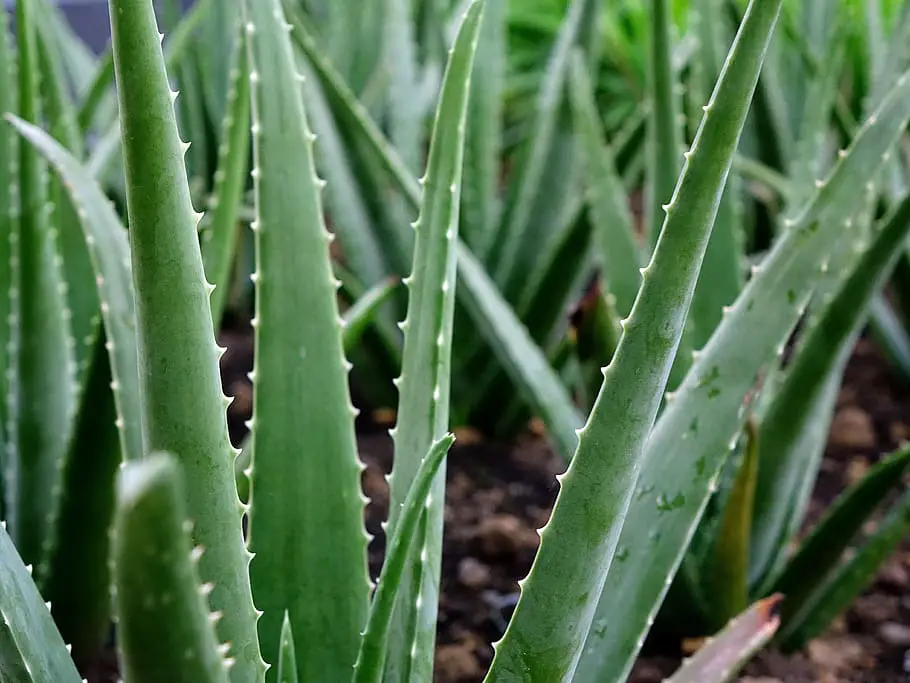
Growing Aloe vera Indoors is easy with the right care tips! Learn about watering, lighting, placement, and Feng Shui benefits for this versatile plant.
Growing Aloe vera Indoors is a fantastic way to add beauty, healing properties, and positive energy to your home.
With the right care tips and Feng Shui guidance, you’ll have a thriving Aloe vera plant that elevates your space and well-being.
Growing Aloe vera Indoors Key Takeaways
- Growing Aloe vera Indoors is simple when you provide bright, indirect light, well-draining soil, and occasional watering.
- Aloe vera thrives in warm temperatures and minimal humidity.
- For Feng Shui benefits, place it near windows or in the entryway to absorb negative energy and promote harmony in your home.
1. Growing Aloe vera Indoors

Costa Farms Aloe vera, Live Succulent Plant, Easy Care Indoor Houseplant in Modern Décor Planter, Room Air Purifier, Tabletop, Office, Desk or Home Décor, Birthday, Gardening Gift, 10-12 Inches Tall
Growing Aloe vera indoors is a great way to bring a touch of nature into your home while benefiting from its medicinal properties.
To thrive indoors, Aloe vera needs conditions similar to its native arid environment.
By paying attention to light, temperature, and soil requirements, you can keep your aloe healthy and vibrant all year long.
Light: Bright and Indirect
Light is one of the most important factors for Aloe vera’s success indoors. While this sun-loving plant thrives in bright conditions, too much direct sunlight can harm its fleshy leaves.
- Best Spot: A south- or west-facing window offers the ideal amount of light without the risk of sunburn.
- What to Avoid: Avoid placing Aloe vera in low-light areas or under harsh, direct sun, as these extremes can lead to unhealthy growth and leaf damage.
Temperature: Keep It Warm and Consistent
Temperature control is essential for Aloe vera, as it’s accustomed to warm, stable conditions in its natural habitat. Sudden changes in temperature can stress the plant.
- Ideal Range: Aloe vera thrives in temperatures between 60°F and 75°F (15°C to 24°C), making it perfect for most indoor environments.
- Placement Tips: Keep the plant away from cold drafts, open windows in winter, and heat sources like radiators that can dry out its leaves.
Soil: Well-Draining is Key
The right soil can make or break your Aloe vera’s health. These plants are prone to root rot if their roots sit in water for too long, so good drainage is critical.
- Best Mix: Use a cactus or succulent potting mix, which is specifically designed for quick drainage. A 50/50 coco coir and perlite mix also works.
- Pot Selection: Choose a pot with drainage holes and avoid decorative planters without proper drainage unless used as outer covers.
With a little attention to these details, your Aloe vera can flourish indoors, bringing its unique charm and soothing qualities to your home.
Aloe vera Plant Care Reference Guide
| Characteristic | Details |
|---|---|
| Common Name | Aloe vera |
| Botanical Name | Aloe barbadensis miller |
| Native Habitat | Tropical and subtropical regions, particularly the Arabian Peninsula |
| Plant Type | Succulent |
| Growth Pattern | Rosette-shaped, with fleshy, lance-shaped leaves |
| Mature Size | 1–2 feet tall and wide |
| Watering | Allow soil to dry out completely between waterings; water deeply but infrequently |
| Light/Sun Exposure | Bright, indirect sunlight; can tolerate some direct light |
| Soil Type | Well-draining cactus or succulent potting mix |
| Soil pH | Slightly acidic to neutral (6.0–7.0) |
| Temperature | 60°F–75°F (15°C–24°C) |
| Humidity | Low to moderate |
| Bloom Time & Flower Color | Rare indoors; when it blooms, tubular yellow flowers appear on a tall stalk |
| Potential Problems | Overwatering, root rot, leaf browning, pests like mealybugs and aphids |
| Repotting | Every 2–3 years or when root-bound; use a slightly larger pot with good drainage |
| Hardiness Zones (USDA) | 8–11 (outdoors); grow indoors in all zones |
2. Feng Shui Placement for Aloe vera
In Feng Shui, Aloe vera isn’t just a beautiful plant it’s a powerful tool for promoting positive energy (Chi) in your home.
Proper placement of this healing plant can create a space filled with balance, protection, and vitality.
Protective Energy: A Natural Shield
Aloe vera is believed to absorb negative energy, acting as a barrier to unwanted vibes.
- Best Placement: Position an Aloe vera plant near the entrance to your home. This helps block harmful energy and welcomes positive vibes.
- Why It Works: Aloe’s natural resilience aligns with Feng Shui principles of creating a protective, harmonious space.
Health and Healing: Aligning with Wellness
In Feng Shui, the east and southeast areas of your home represent health and family.
- Enhancing Energy: Placing Aloe vera in these zones amplifies its symbolic healing properties.
- Family Well-Being: The plant’s calming presence promotes harmony and strengthens family connections.
Placement Tips
- Use decorative pots that complement your home’s energy while providing proper drainage.
- Avoid clutter around the plant, as this can block the flow of positive energy.
By placing Aloe vera strategically, you can protect your home from negativity and foster a nurturing environment filled with good health and balance.
3. Aloe vera Watering and Lighting Needs
Getting the watering and lighting just right is the secret to a thriving Aloe vera plant.
While this hardy succulent is forgiving, providing the right balance will keep it looking vibrant and healthy.
Think of it as giving your aloe the care it needs to do its best work—whether that’s looking great in your space or offering its healing gel.
Watering: Deep, Infrequent, and Thoughtful
Aloe vera doesn’t like to sit in water, and overwatering is one of the quickest ways to cause trouble.
- When to Water: Let the soil dry out completely between waterings. Check by sticking your finger an inch into the soil—it should feel dry before you grab the watering can.
- How Often: Water deeply but only every 2–3 weeks, adjusting based on your home’s humidity and temperature.
- Avoid Overwatering: Too much water can cause root rot, so be cautious. A good soak followed by a long dry spell is better than frequent splashes.
Lighting: Bright and Indirect is Best
Light is just as important as water for keeping aloe happy. While they love sunshine, they need it in the right amount.
- Natural Light: Place your aloe near a bright window with indirect light. South- or west-facing windows are ideal.
- Artificial Light: If natural light is lacking, a grow light can fill the gap. Keep the light source about 12–18 inches above the plant for optimal growth.
- What to Avoid: Harsh direct sunlight can scorch the leaves, leaving unsightly brown patches.
By giving your Aloe vera thoughtful watering and positioning it in a well-lit spot, you’ll set it up to thrive and bring beauty and energy to your home.
4. Aloe vera’s Protective Feng Shui Benefits
 Live Aloe Vera Plant Live Succulents Plants Live Plants (1G), Aloe Plant Live Succulent Plants Live Aloe Plants Live Houseplants, Aloe Vera Plant Indoor Succulents Indoor Plants by Plants for Pets
Live Aloe Vera Plant Live Succulents Plants Live Plants (1G), Aloe Plant Live Succulent Plants Live Aloe Plants Live Houseplants, Aloe Vera Plant Indoor Succulents Indoor Plants by Plants for Pets
Aloe vera isn’t just a healing plant. It’s also a symbol of protection and positivity in Feng Shui.
Its presence can help transform your home into a sanctuary of balance and well-being, combining its natural benefits with its powerful, energetic properties.
Negative Energy Absorption
Aloe vera is believed to act as a natural sponge for negativity, helping to neutralize harmful energy in your space.
- Symbolism: The plant’s sturdy, fleshy leaves are seen as shields that protect your home and its occupants.
- Placement Tips: Position Aloe vera near entryways or windows to block negative energy from entering your home while allowing positivity to flow.
Air Purification and Chi Enhancement
Aloe vera doesn’t just cleanse energy—it also purifies the air, making it a dual-purpose plant for both Feng Shui and health.
- How It Helps: The plant filters toxins like formaldehyde and benzene, creating a fresher, healthier indoor environment.
- Impact on Chi: Clean air promotes a smoother flow of Chi, uplifting the overall energy in your home.
Learn more about Chi and indoor plants
Maximizing Aloe vera’s Feng Shui Benefits
- Keep the plant healthy and vibrant, as neglected plants can disrupt energy flow.
- Pair Aloe vera with other Feng Shui elements, like water features or earthy decor, to create a balanced and harmonious space.
By integrating Aloe vera into your home with care and intention, you’ll enjoy its dual benefits of protection and positivity while enhancing your overall living environment.
5. Propagating Aloe vera
Growing your Aloe vera family is as simple as keeping an eye out for its natural growth process.
With a little patience and care, you can propagate new plants from the offsets (or “pups”) that mature plants produce.
It’s a fun and satisfying way to expand your collection or share this amazing plant with friends.
Offsets (Pups): Nature’s Gift for Propagation
Mature Aloe vera plants naturally produce offsets, or “pups,” around their base. These mini aloe plants are ready to start their own journey once they’ve grown big enough.
- When to Separate: Wait until the pups are 3–4 inches tall and have their own roots before separating them from the mother plant.
- How to Remove Them: Gently remove the Aloe vera from its pot and carefully loosen the soil around the pups. Use clean hands or a knife to separate the pups, ensuring each one has some roots attached.
- Replanting: Place each pup in a small pot filled with well-draining cactus or succulent soil. Water lightly and let them settle into their new homes.
Care for Newly Planted Pups
Newly propagated Aloe vera plants need a little extra attention to thrive.
- Light: Place the pots in bright, indirect light to help them establish themselves without stress.
- Watering: Hold off on watering for a few days to let any wounds heal and avoid rot. After that, follow the same deep but infrequent watering schedule as mature plants.
Propagation helps you grow your Aloe vera collection and gives you a chance to spread a little plant love to others.
Watching these pups grow into mature plants is incredibly rewarding!
6. Troubleshooting Aloe vera Problems
Even the hardiest plants, like Aloe vera, can encounter a few hiccups. Knowing how to identify and resolve common problems will help keep your aloe healthy and thriving.
Whether it’s watering issues, environmental stress, or pests, a little attention can go a long way.
Wilting or Soft Leaves: Overwatering Alert
Aloe vera thrives on deep but infrequent watering and too much water is a common mistake.
- Signs: Soft, mushy, or drooping leaves often signal overwatering or poor drainage.
- Fix It: Allow the soil to dry out completely before watering again. If the issue persists, check the pot for drainage holes and consider repotting in fresh, well-draining soil.
Browning Tips: Adjust Light and Humidity
Browning leaf tips can ruin the look of your aloe but are usually easy to address.
- Signs: Dry, crispy tips are often caused by excessive direct sunlight or low indoor humidity.
- Fix It: Move your aloe to a spot with bright indirect light. If your home is particularly dry, consider misting the air around the plant occasionally or using a humidifier.
Pests: Unwanted Visitors
While Aloe vera isn’t a magnet for pests, infestations can occasionally occur.
- Signs: Look for sticky residue, small bugs, or cottony clusters—common signs of pests like mealybugs or aphids.
- Fix It: Wipe the leaves with a damp cloth to remove pests, then treat the plant with insecticidal soap or neem oil to prevent further problems.
Preventative Tips
- Avoid overwatering by following a consistent schedule and letting the soil dry out completely.
- Check your aloe regularly for pests or signs of stress, especially if it’s near other plants.
- Ensure proper drainage and avoid keeping the plant in overly humid or poorly lit areas.
By addressing these issues promptly, you’ll keep your Aloe vera looking fresh and healthy while enjoying all the benefits it brings to your home.
7. Aloe vera as a Medicinal Plant
Aloe vera is a powerhouse when it comes to natural healing. This versatile plant isn’t just a decorative addition to your home.
It’s also a living first-aid kit, and it contributes to better indoor air quality.
The combination of practical uses and symbolic health benefits make it a favorite for households everywhere.
Skin Soothing: Nature’s Remedy for Burns and Irritations
The gel inside Aloe vera leaves is packed with soothing properties that make it a go-to for minor skin issues.
- How It Helps: The gel is naturally cooling and anti-inflammatory, making it ideal for treating minor burns, cuts, and sunburns.
- How to Use: Simply cut a mature leaf, scoop out the gel, and apply it directly to the affected area for quick relief.
Air Quality Improvement: Breathing Easier with Aloe
Beyond its topical benefits, Aloe vera also works behind the scenes to improve your indoor environment.
- How It Helps: Aloe vera absorbs toxins like formaldehyde and benzene, common in household air, and releases oxygen, promoting cleaner air.
- Feng Shui Connection: Purified air enhances the flow of Chi, aligning with Feng Shui principles of health and vitality.
Tips for Maximizing Medicinal Benefits
- Keep your Aloe vera healthy and vibrant to ensure the gel is fresh and effective.
- Harvest leaves responsibly, cutting only the mature outer ones so the plant continues to grow.
Aloe vera’s dual role as a healer and air purifier makes it an invaluable addition to your home, offering benefits that go far beyond its beauty.
8. Choosing the Right Pot for Aloe vera
The pot you choose for your Aloe vera is just as important as the care you provide.
A well-suited pot helps maintain proper moisture levels and supports the plant’s overall health.
With thoughtful choices, you can set your Aloe vera up for long-term success.
Material: Terracotta for the Win
Terracotta pots are a fantastic choice for Aloe vera due to their natural breathability.
- Why It Works: These porous pots help excess moisture evaporate, reducing the risk of root rot.
- Other Options: Ceramic pots can also work well if they have proper drainage, but avoid plastic pots, as they can trap moisture.
Size: Just Right is Key
When it comes to pot size, balance is everything.
- What to Look For: Choose a pot that fits the plant’s root system snugly, with about an inch of space around the roots for growth.
- What to Avoid: Oversized pots can retain too much moisture, increasing the risk of overwatering issues.
Drainage: Non-Negotiable
Proper drainage is essential for any succulent, and Aloe vera is no exception.
- What to Ensure: The pot should have at least one drainage hole to allow excess water to escape.
- Bonus Tip: Use a saucer beneath the pot to catch draining water and prevent messes.
Feng Shui Tip: Aesthetic Matters
While functionality is key, the pot should also complement your home’s decor and energy.
Choose a pot with earthy tones or natural materials to align with Feng Shui principles, promoting stability and harmony.
A well-chosen pot keeps your Aloe vera healthy and adds to the plant’s overall beauty and positive presence in your space.
9. Seasonal Care for Aloe vera Plants
Like all plants, Aloe vera has different needs depending on the time of year.
Adjusting your care routine to match the seasons will keep your aloe healthy and thriving, whether it’s growing vigorously in the summer or resting in the winter.
Spring and Summer: Active Growth Season
Aloe vera comes to life in warmer months, so this is the time to give it a little extra attention.
- Watering: Water more frequently, but still let the soil dry out between waterings. Depending on your home’s temperature and humidity, this may mean every 1–2 weeks.
- Fertilizing: Feed the plant once a month with a diluted, balanced fertilizer to support active growth.
- Light: Make sure it gets plenty of bright, indirect light, but protect it from harsh, direct sun that can scorch its leaves.
Fall and Winter: Resting Period
As the days shorten and temperatures cool, Aloe vera naturally slows its growth.
- Watering: Reduce watering frequency to every 3–4 weeks, as the plant’s water needs decrease during dormancy. Overwatering during this time can lead to root rot.
- Light: With less natural light available, consider supplementing with a grow light to keep the plant healthy and prevent leggy growth.
- Placement: Keep your aloe away from cold drafts, heaters, or areas with fluctuating temperatures.
Feng Shui Tip: Seasonal Energy Balance
In Feng Shui, aligning plant care with seasonal cycles mirrors the flow of Yin and Yang energies.
During active growth in spring and summer (Yang), nourish your plant with water and fertilizer.
In fall and winter (Yin), scale back to reflect the plant’s restful phase, promoting harmony in your home.
Adapting your care routine with the seasons ensures your Aloe vera remains vibrant year-round, adding beauty and balance to your indoor space.
10. Aloe vera for Workspace Feng Shui
Adding Aloe vera to your workspace is more than a decorative choice. It’s a way to create a calm, productive environment that supports your focus and overall well-being.
This resilient plant offers a combination of aesthetic beauty, health benefits, and Feng Shui advantages, making it a perfect desk companion.
Focus and Productivity: Encouraging Calm and Concentration
Aloe vera is believed to promote a focused and tranquil atmosphere, helping you stay on task.
- Why It Helps: Its presence can absorb negative energy, creating a peaceful space conducive to concentration.
- Best Placement: Position your aloe on your desk or in a nearby spot where it can balance energy without cluttering your workspace.
Stress Reduction: Breathing Easier While You Work
A healthier workspace means less stress, and Aloe vera contributes to this in multiple ways.
- Air Purification: Aloe vera filters toxins and improves air quality, promoting a fresher and more comfortable environment.
- Energy Flow: Its role in Feng Shui aligns with the principles of reducing stress and encouraging positive Chi.
Feng Shui Tip: Balance and Energy Flow
- Place Aloe vera in the East or Southeast corner of your workspace to enhance growth, wealth, and harmony.
- Use pots with earthy tones or natural materials to ground the plant’s energy and complement the overall balance of your workspace.
Integrating Aloe vera into your workspace blends functionality with Feng Shui principles, helping you create a space that supports productivity, reduces stress, and looks fantastic.
Aloe vera Care Indoors FAQs
Curious about how to keep your Aloe vera plant thriving indoors? Here are answers to the most common questions about caring for this hardy and beneficial plant.
Q. How much sunlight does Aloe vera need indoors?
A. Aloe vera needs bright, indirect sunlight to thrive. A south- or west-facing window is ideal. Avoid prolonged direct sun, which can scorch the leaves.
Q. How often should I water my indoor Aloe vera?
A. Water when the soil is completely dry, usually every 2–3 weeks. Overwatering is a common cause of root rot, so ensure the pot has good drainage.
Q. What type of soil is best for Aloe vera?
A. Use a well-draining cactus or succulent potting mix. Adding sand or perlite to regular soil can improve drainage.
Q. Can Aloe vera survive in low light?
A. Aloe vera prefers bright light but can tolerate low light temporarily. However, growth may slow, and the plant could become leggy.
Q. Where should I place Aloe vera for Feng Shui benefits?
A. Place Aloe vera near a window or entryway to absorb negative energy and encourage protective energy flow in your home.
Growing Aloe vera Indoors Conclusion
Growing Aloe vera Indoors is not just about maintaining a beautiful plant it’s also about integrating healing, protection, and positive energy into your home.
With the right care and mindful placement, Aloe vera can thrive while uplifting your space and well-being.
Care Essentials
- Provide bright, indirect sunlight and maintain warm indoor temperatures.
- Use well-draining soil and water deeply but infrequently, allowing the soil to dry completely between waterings.
Feng Shui Benefits
- Position Aloe vera near windows or entryways to block negative energy and promote harmony.
- Leverage its air-purifying qualities and protective symbolism to enhance your home’s energy flow.
Aloe vera Key Takeaways
- Bright, indirect light and well-draining soil are the foundation of healthy Aloe vera care.
- Overwatering is a common mistake—let the soil dry out before watering again.
- Aloe vera’s Feng Shui placement near windows or entrances helps foster harmony and protection.
- Beyond its aesthetic appeal, Aloe vera offers medicinal benefits and improves air quality.
Aloe vera is more than just a plant. It’s a living symbol of resilience, healing, and balance.
By understanding its needs and the Feng Shui principles that amplify its benefits, you’ll create a thriving, harmonious environment that brings beauty, energy, and practical value to your home all year round.🌱
✨ Indoor Plants and Feng Shui
Enhance harmony, balance, and positive energy in your home with these Feng Shui indoor plant guides.
- 🌱 Feng Shui Plants (Pillar Guide)
- 🏡 Indoor Plants and Feng Shui
- 🌿 Feng Shui Vertical Gardens for Office Spaces
- 🌸 Best 24 Feng Shui Indoor Plants
- 💧 Growing Feng Shui Plants
- 🌳 Common Chinese House Plants for Feng Shui
- 🪴 Feng Shui Hanging Plants
- 🛏️ Feng Shui Bedroom Plants
- 🍃 ZZ Plant Feng Shui
- 🌱 Using Feng Shui in Vertical Gardens
- 🎋 Growing Lucky Bamboo in Feng Shui
- 🏠 Indoor Plants for Feng Shui
- ☯️ Indoor Plants for Positive Energy
- 🌼 Chinese Evergreen Care
- 🌺 Growing Peonies Indoors and Outdoors
- See all articles in our Indoor Plants and Feng Shui category
Related Content
Visit my Amazon Influencer Page for videos and gardening products Grow Your Own Garden

